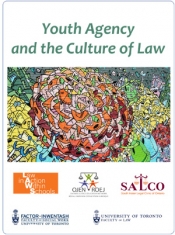By Lucianna Ciccocioppo

JD/MSW student Persia Etemadi
If you think “forced” marriages are not an issue in Canada—think again. Not only does it occur in this country, but it crosses cultural, religious and socioeconomic boundaries, according to a 2013 report by the South Asian Legal Clinic of Ontario (SALCO).
It found a survey of 30 community agencies reported having served 219 forced marriage clients from 2010-2012.
The report made the news, and had Canadians talking. The issue caught the world’s attention, at a 2014 UN General Assembly Human Rights Council and a Commonwealth Roundtable.
That’s why JD/MSW student Persia Etemadi was keen to work on a project that aims to empower youth to think about their legal rights—and stand up for them. Led by the Faculty of Law’s Professor Anver Emon, and co-sponsored by the Factor-Inwentash Faculty of Social Work Dean Faye Mishna, the project has developed a high school curriculum on this very topic.
“If teachers and the community start to use it, it can be a really good preventative tool,” says Etemadi, who has an undergraduate degree in psychology from McGill University. She argues raising awareness about youth rights is more effective than trying to criminalize forced marriages, which many countries, including Canada, are trying to do. Earlier this year, the federal government introduced Bill S-7, the Zero Tolerance for Barbaric Cultural Practices Act.
Etemadi fears the bill, if passed, could actually backfire.
“It stigmatizes the communities that are associated with forced marriage,” explains Etemadi, “and creates a disincentive for people to report forced marriage because it puts their families at risk. We think the better approach is a preventative one that focuses on education, and looks at forced marriage through a broader analysis of how the law understands youth and their capacity.”
Forced marriage m eans there’s an absence of consent from one or both parties, and it’s defined as a form of domestic violence and a global human rights issue in the SALCO report. While many cases of forced marriage involve females, some are gay youth, whose parents are trying to ‘fix’ them and change their sexual preferences. There are also cases in Christian sects. Some involve immigration issues. All involve coercion and emotional duress.
eans there’s an absence of consent from one or both parties, and it’s defined as a form of domestic violence and a global human rights issue in the SALCO report. While many cases of forced marriage involve females, some are gay youth, whose parents are trying to ‘fix’ them and change their sexual preferences. There are also cases in Christian sects. Some involve immigration issues. All involve coercion and emotional duress.
“The issue of forced marriage brings to the forefront our presumptions about consent. What it means, who has it, and how it gets expressed are all wrapped up into how we understand when something is or isn’t forced, compelled, or coerced,” says Prof. Emon, Canada Research Chair in Religion, Pluralism and the Rule of Law.
“I am interested in showcasing how the law gives those presumptions direct expression, and thereby contributes to a culture of what consent is and who has it. To show the law’s culture on consent therefore is to also showcase the law’s culture of adolescents. As much as we are committed to a view of the liberal, autonomous agent, the law acts paternalistically on the bodies of citizens in different settings, adolescence being one of them.”
Emon led a team of researchers and education specialists to draft a high school curriculum that asks questions, spurs classroom discussion and raises complex issues surrounding forced marriage. Hypothetical and actual case studies look at some of the fears, such as: “Is my family going to disown me? What’s going to happen to me?”
Working closely with curriculum consultant Allan Hux, a board member of the law school’s Law in Action within Schools program (LAWS), Etemadi spent two years on the project drafting and redrafting the lesson components to ensure compliance with the Ministry of Education. Sarah Pole, LAWS director, piloted the curriculum among teacher and student focus groups, and social work dean Prof. Mishna led a community forum. It kept the curriculum “real”, says Emon.
There are many agencies that do a lot of work on this issue, but everyone has a role. We’re in a good position in law to do this type of project.
“It has been important to us that we make a curriculum that not only works for teachers, but that also speaks to the on-the-ground realities faced by front-line workers across the GTA and elsewhere,” Emon explains. “Persia’s commitment to both law and social work made her especially qualified to do this sort of work, engage these different stakeholders, and bring this project to completion.”
Youth Agency and the Culture of Law is now available in English and French for classroom use. It can be downloaded from various websites, such as Ontario Justice Education Network, SALCO and the Factor-Inwentash Faculty of Social Work, with full lesson plans as a toolkit for teachers. Frontline workers at community agencies can also get modified versions in Arabic, Punjabi and Urdu.
The legal concepts of guardianship, minimum marriage age and age of majority are included, as are case studies, to develop and encourage the teens’ critical thinking around the law and what it suggests about the capacity of young people to make legal decisions. Etemadi, whose interests in social justice and policy led her to pursue the joint law-social work degree, says the curriculum is aimed at senior high school civics, law and family studies courses, and those examining equity and global issues.
“It’s about youth agency and civic responsibility in a Canadian context. The goal is to engage students on how the law understands youth and treats them differently,” Etemadi explains. “It’s a tool that can be used by all young people, even if to give youth a broad understanding of the law, and how relevant it is to their lives.”
Etemadi is optimistic the curriculum can have an impact. “It’s a small piece. There are many agencies that do a lot of work on this issue, but everyone has a role. We’re in a good position in law to do this type of project.”
Emon calls Etemadi ‘the heart and soul’ of the initiative. “She brought to this project a real commitment to education and service.”
Read the in-depth feature story, coming up in the Spring/Summer 2015 issue of Nexus


 eans there’s an absence of consent from one or both parties, and it’s defined as a form of domestic violence and a global human rights issue in the SALCO report. While many cases of forced marriage involve females, some are gay youth, whose parents are trying to ‘fix’ them and change their sexual preferences. There are also cases in Christian sects. Some involve immigration issues. All involve coercion and emotional duress.
eans there’s an absence of consent from one or both parties, and it’s defined as a form of domestic violence and a global human rights issue in the SALCO report. While many cases of forced marriage involve females, some are gay youth, whose parents are trying to ‘fix’ them and change their sexual preferences. There are also cases in Christian sects. Some involve immigration issues. All involve coercion and emotional duress.